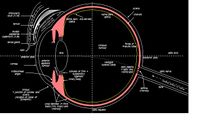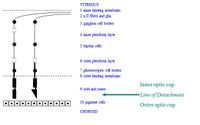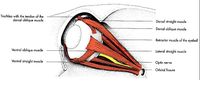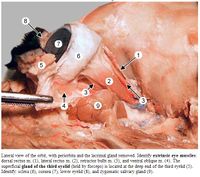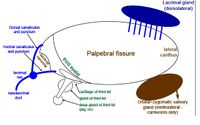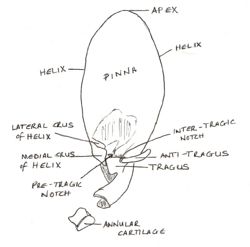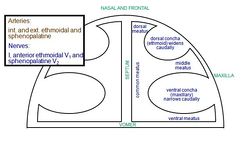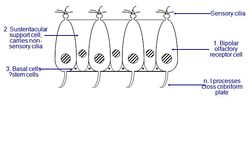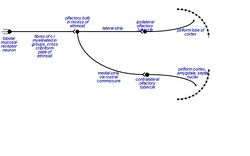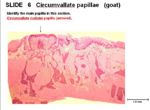Difference between revisions of "Equine Special Senses - Horse Anatomy"
(→Eye) |
(→Adnexa) |
||
| Line 159: | Line 159: | ||
[[Image:Adnexa.jpg|thumb|right|200px|Adnexa - Copyright David Bainbridge]] | [[Image:Adnexa.jpg|thumb|right|200px|Adnexa - Copyright David Bainbridge]] | ||
| − | The adnexa refers to the accessory structures of the eye, including the eyelids and the lacrimal apparatus. | + | The adnexa refers to the accessory structures of the eye, including the eyelids and the lacrimal apparatus. |
| + | =====Lacrimal Apparatus===== | ||
| + | Function of the cornea depends on the integrity of the lacrimal system, a major component is the '''pre-corneal tear film'''. This is the outer-most layer of the corneal epithelium, it should stay attached to the corneal and conjunctival surface. Pre-corneal tear film functions to: | ||
| + | *Lubricate the cornea and conjunctiva, blinking spreads it over the surface. | ||
| + | *Transfer oxygen and glucose to the avascular cornea | ||
| + | *Provides antibodies/inflammatory cells to the cornea in the event of an irritation or foreign body. | ||
| + | *Flushes away foreign body material. | ||
| + | *Maintains an optically smooth corneal surface so that light can pass freely into the cornea. | ||
| − | + | The '''pre-corneal tear film''' is made up of three major constituents: | |
| − | + | *Lipid outer layer: produced by the '''tarsal aka meibomian glands''' (modified sebaceous glands) in the '''tarsal plate''' of the eyelids. This prevents evaporation of the underlying layers and overflow of tear film onto the eyelids; therefore it stops dehydration of the cornea. | |
| − | + | *Aqueous layer: in the middle, performs the primary functions of the tear film. The '''lacrimal gland''', '''superficial gland of the nicitating membrane''' and, '''Hardenian gland''' and '''accessory lacrimal glands''' in the conjunctiva contribute to its formation. Evaluate this layer with the Shirmir Tear Test. | |
| − | + | *Mucin: is the inner layer which sticks the aqueous phase to the corneal epithelium. It is produced by conjunctival goblet cells, mainly in the '''conjunctival fornixes'''. Evaluate with fluorescein breakup time. | |
| − | |||
==Ear== | ==Ear== | ||
Revision as of 16:34, 22 November 2012
Eye
Introduction
The eye is a paired organ, the organ of vision. The eye is made up of various components, which enable it to receive light stimuli from the environment, and deliver this stimuli to the brain in the form of an electrical signal. Vision involves all components of the eye. The eye is contained within the bony orbit of the head. The bony orbit is a cavity, comprising parts of the lacrimal bone (includes fossa for nasolacrimal duct) and the maxilla (includes caudal foramen of infraorbital canal). It is continuous with the temporal bone and the pterygopalatine fossa caudally. The bony orbit is located laterally in horses, as they are in most prey species. This allows horses a range of vision of more than 350°. However this wide range of monocular vision has two 'blind spots', these are straight in front of the face and directly behind the head, extending over the back and tail. This is important to consider when approaching a horse.
Movement of the eyeball is achieved through the contraction and relaxation of six extraocular muscles:
- Dorsal rectus muscle
- Ventral rectus muscle
- Medial rectus muscle
- Lateral rectus muscle
- Dorsal oblique muscle
- Ventral oblique muscle
The Transparent Media (conjunctiva, cornea, lens, and vitreous and aqueous humour)
Conjunctiva
The conjunctiva is continuous with the skin of the eyelids. The palpebral conjunctiva is the part of the conjunctiva that covers the inner surface of the eyelid, the bulbar conjunctiva covers the surface of the eyeball. It is lined by stratified squamous epithelium, and contains goblet cells, which secrete the deepest, mucus, layer of tear film, which adheres to the surface of the globe. It is highly vascular.
Cornea
The cornea and sclera together make up the tough outer, supportive structure of the eye. Although the cornea has the same composition as the sclera, it is transparent. The main function of the cornea is to refract light. The hallmark of corneal disease is opacity. The transparency of the cornea is partially due to the organization of stromal collagen, but the endothelium plays a critical role as it keeps the cornea in a constant state of relative dehydration. It is avascular, so nutrients and oxygen are obtained from the aqueous humour, and oxygen is also obtained from air. The cornea joins with the sclera at the point of the limbus; the sclera is vascular, but otherwise similar to the cornea.
The layers of the cornea are:
1. (conjunctiva)
2. Bowman’s membrane (basal lamina)
3. Thick transparent fibrous layer
4. Descement’s membrane
5. Endothelium (inner lining of the cornea)
The corneal epithelium consists of an outer layer of squamous cells, a middle layer of polyhedral cells and an inner single layer of columnar cells that produce the basement membrane. The epithelium is attached to the basement membrane by hemidesmosomes and fine fibrils link the basal epithelium, basement membrane and subepithelial stroma.
The stroma (substantia propria)comprises the bulk of the cornea, consisting primarily of keratinocytes, regularly arranged collagen fibrils and ground substance. Fibrils are arranged in sheet-like bundles (lamellae) that extend across the entire width of the cornea, from limbus to limbus; this arrangement helps to maintain transparency. The ground substance of proteoglycans and glycosaminoglycans (GAGs) & glycoproteins occupies the space between lamellae. The keratinocytes have a slow turnover rate in the normal adult cornea, but if there is a corneal insult they can become active fibroblasts and produce precursors of collagen and ground substance. Other cells such as leukocytes, lymphocytes and macrophages are rare in the normal cornea.
The corneal endothelium produces Descemet’s membrane throughout life, but its own powers of replication diminish in early life. When endothelial cells die, they are replaced by neighbouring cells spreading to fill the gap. Consequently, the endothelium thins and descemet’s membrane thickens with age. The endothelium is a single layer of cells of high metabolic activity and are crucial in maintaining dehydration of the cornea and thus corneal clarity. The endothelial cells actively pump fluid that can accumulate, from tear film etc, out of the cornea.
Aqueous Humour
Aqueous humour is produced by ciliary processes of the ciliary body. It is a transparent ultra-filtrate of plasma. Its continual flow is vital for the delivery of nutrients and removal of waste products to the avascular structures it bathes; lens, inner portion of the cornea (including corneal endothelium) and trabecular meshwork. Once produced aqueous traverses the posterior chamber, passes through the pupil and enters the anterior chamber where it can then drain at the iridiocorneal angle. The aqueous is optically clear under normal conditions, a property important for vision. An opacity in the aqueous humour is usually the result of an inflammatory process. The blood-aqueous barrier to free diffusion of molecules is formed by the tight junction between non-pigmented epithelial cells of the ciliary body. Breakdown of this barrier occurs in many conditions, including inflammation, trauma and vascular disease. Interventions such as paracentesis and surgery also causes breakdown, as does topical administration of drugs such as pilocarpine. Typically, the aqueous humour becomes turbid (aqueous flare) because of leakage of plasma proteins into the anterior and posterior chambers due to the damaged barrier and loss of vessel integrity. Fibrinogen and other proteins render the aqueous ‘plasmoid’, as its protein content approaches that of plasma, and when inflammation is severe fibrin clots may form. The cellular component varies according to the underlying aetiology. A preponderance of white blood cells is termed hypopyon and a preponderance of red blood cells is called hyphaema. It also maintains intraocular pressure (25mm.Hg), and is replaced several times a day (2µl/min). An increase in intraocular pressure can cause glaucoma.
Lens
The lens is about 65% water; protein is the other main component. The basement membrane of the lens epithelial cells creates the lens capsule, which envelops the body of the lens. The capsule is an elastic membrane, which is semi-permeable and allows passage of metabolites. The anterior lens capsule is much thicker than the posterior lens capsule.
Throughout life, lens epithelial cells at the equator of the lens undergo mitosis and are pushed towards the ‘lens bow’ where they elongate producing layers of lens fibers that extend into the anterior and posterior cortex. The fibers are continually pressed inward by newly formed fibers and then lose their nuclei. As each fiber elongates, it curves around the deeper and older fibers. The tips of the lens fibers from different regions of the equator meet in a radiating pattern of lines known as sutures. These lines usually form a ‘y’ on the anterior surface of the lens and an ‘inverted y’ on the posterior surface. The suture line can sometimes be helpful in determining the location of an opacity within the lens.
The mature lens is transparent and biconvex. The centers of the lens surface are referred to as the anterior and posterior poles. The circumference of the lens is known as the equator. The center of the lens itself is referred to as the nucleus, which is surrounded by the lens cortex. Attached to the lens equator are zonular ligaments; the zonules attach the lens to the ciliary body and mediate accommodation. Contraction of the ciliary body muscles relieves tension on the zonules, which in turn, allows the elastic capsule to retract; this causes the lens to become more convex. This change in the shape of the lens changes the focal length of the lens.
The lens metabolizes mostly through anaerobic glycolysis; metabolism is limited by the avascular state of the lens and low oxygen supply. The lens is completely dependent on the aqueous humor for nutrients. Pathological changes within the lens result in deposition of lens protein, disruption of lens fibres and hence loss of lens transparency known as a cataract.
Vitreous Humour
The vitreous humour is a transparent hydrogel that occupies almost 3/4 of the volume of the eye in the posterior segment of the globe; it is composed of 99% water with collagen fibrils as a skeleton for hylaronic acid. The vitreous body is attached to peripheral structures only at the edge of the optic nerve, near the ora serrata and at the posterior lens capsule. It acts as a clear medium for transmission of light between the lens and retina and provides mechanical support for the internal structures of the eye.
The Wall (retina, uvea and sclera)
The retina is the inner layer of the eyeball, it develops from the optic vesicle, which is an outgrowth of the diencephalon. It remains connected to the diencephalon via the {Equine Cranial Nerves - Horse Anatomy#Optic Nerve (II)|optic nerve]]. It can be divided into the non-visual retina (lines the back of the ciliary body) and the optic part of the retina.
The non-visual part of the retina is lined by inner and outer single-layers of epithelium; the outer layer is pigmented, the inner layer is neural. This neural inner layer contains photoreceptors, interneurons, ganglion cells and associated stromal cells, called MÜLLER cells. Rods and cones are photosensitive receptor cells, and are found in the optic part of the retina. Rods are mainly utilised at night, as they are highly sensitive receptors to black and white, while cones are mainly utilised during the day as they are used for colour vision. The fovea is an area of the retina that contains mostly cones, and in high numbers. Here, oxygen is obtained from the choroid (a pigmented layer that makes up part of the uveal tract - mentioned further down) by diffusion. In this region, there is one nerve fibre per cone.
Layers of the retina, from vitreous humour to choroid:
1. Inner limiting membrane
2. Optic nerve fibres and axons of ganglion cells
3. Ganglion cell bodies
4. Inner plexiform layer - synapse of bipolar cells with ganglion cells
5. Inner nuclear layer – nuclei of bipolar cells
6. Outer plexiform layer - synapses of photoreceptors with bipolar cells
7. Outer nuclear layer – photoreceptor cell nuclei
8. Outer limiting membrane
9. Photoreceptor layer – rods and cones
Line of Detachment
10. Pigment cells – retinal pigmented epithelium
Uveal Tract
The uveal tract is a three-part physiological and pathological unit, positioned between the sclera and the retina:
1. Choroid: pigmented, highly vascular layer, containing:
a. tapetum lucidum (inner layer, nearest retina): reflective and coloured, so increases sensitivity to poor light
b. vascular layer: nutritive
c. black/connective layer (outer layer, nearest sclera)
2. Ciliary body: produces aqueous humour and vitreous humour, and is involved in lens accommodation, as its muscle fibres stretch the lens into a flatter shape, allowing distant vision
3. Iris: vascular, coloured, and contractile for pupil size
Sclera
The sclera is continuous with the cornea at the point of the limbus. It is similar to the cornea, except that it is vascular, and has dense, irregular, fibrous connective tissue.
Around the Eye (Adnexa)
Extraocular Muscles
| Muscle | Innervation | Function |
|---|---|---|
| Dorsal Rectus | Oculomotor nerve
(CN III) |
Elevates the eyeball |
| Ventral Rectus | Oculomotor nerve
(CN III) |
Depresses the eyeball |
| Medial Rectus | Oculomotor nerve
(CN III) |
Adduction of the eyeball |
| Ventral Oblique | Oculomotor nerve
(CN III) |
Outward rotation of the eyeball |
| Levator Palpebrae Superioris | Oculomotor nerve
(CN III) |
Elevates the upper eyelid |
| Lateral Rectus | Abducens nerve
(CN VI) |
Abduction of the eyeball |
| Retractor Bulbi | Abducens nerve
(CN VI) |
Retracts the eyeball |
| Dorsal Oblique | Trochlear nerve
(CN IV) |
Inward roation of the eyeball |
All of the extraocular muscles originate at the equator of the eyeball.
Adnexa
The adnexa refers to the accessory structures of the eye, including the eyelids and the lacrimal apparatus.
Lacrimal Apparatus
Function of the cornea depends on the integrity of the lacrimal system, a major component is the pre-corneal tear film. This is the outer-most layer of the corneal epithelium, it should stay attached to the corneal and conjunctival surface. Pre-corneal tear film functions to:
- Lubricate the cornea and conjunctiva, blinking spreads it over the surface.
- Transfer oxygen and glucose to the avascular cornea
- Provides antibodies/inflammatory cells to the cornea in the event of an irritation or foreign body.
- Flushes away foreign body material.
- Maintains an optically smooth corneal surface so that light can pass freely into the cornea.
The pre-corneal tear film is made up of three major constituents:
- Lipid outer layer: produced by the tarsal aka meibomian glands (modified sebaceous glands) in the tarsal plate of the eyelids. This prevents evaporation of the underlying layers and overflow of tear film onto the eyelids; therefore it stops dehydration of the cornea.
- Aqueous layer: in the middle, performs the primary functions of the tear film. The lacrimal gland, superficial gland of the nicitating membrane and, Hardenian gland and accessory lacrimal glands in the conjunctiva contribute to its formation. Evaluate this layer with the Shirmir Tear Test.
- Mucin: is the inner layer which sticks the aqueous phase to the corneal epithelium. It is produced by conjunctival goblet cells, mainly in the conjunctival fornixes. Evaluate with fluorescein breakup time.
Ear
The ear is a paired sensory organ, that is involved in both hearing and balance. For this reason, the ear is known as the vestibulocochlear organ. Sound waves that are transmitted into the ear provide a mechanical stimulus. These mechanical stimuli are then transferred into electrical signals by the cochlea. Neuroreceptors in the ear allow the horse to gain a perception of position and movement. Anatomically, the ear can be looked at in three parts:
1. Outer ear - pinna and auditory canal
2. Middle ear - contains the malleus, incus and stapes bones - known as the ossicles
3. Inner ear - contains the membranous and bony labyrinths, and the cochlea
Outer Ear
This includes the pinna and the ear canal (external auditory meatus) down to the level of the tympanic membrane. The pinna (or auricle) comprises the auricular cartilage, which is flared distally into a flattened cone shape, covered by skin on both sides - more tightly on the medial or concave side than the convex side. This is the outer projecting part of the ear that can be seen. The hair covering on the convex side is usually similar to the rest of the body but the hair covering on the concave or medial aspect is variable. There are also irregularities on the concave surface with ridges and prominences, the medial and lateral crus of the helix on the medial aspect of the opening of the external ear canal, opposite the rectangular tragus on the lateral aspect. The functional shape of the pinna in horses is erect, and the muscular connections at the base of the pinna allowing positional adjustments to efficiently collect sound. Proximally, the auricular cartilage is rolled into a funnel shape, known as the concha. The scutiform cartilage lies rostromedially in the lower ear canal and provides support. The annular cartilage lies between the proximal horizontal ear canal and the bony acoustic process of the typmanic bulla, connected by ligaments. The vertical ear canal lies in a rostroventral orientation before bending medially to become the horizontal canal. These cartilages fit into the bony passage of the ear canal - also called the external auditory meatus, which leads to the tympanic membrane. This is the deepest boundary of the outer ear.
Muscles around the base of the ear that are attached to the skull allow movement of the pinna, so the ear can be directed to the source of sound:
| Muscle | Origin | Innervation | Function |
|---|---|---|---|
| Preauricular | Deep temporal fascia | Auriculopalpebral branch of facial nerve
(cranial nerve VII) |
Moves the ear cranio-laterally, so the pinna is facing forwards |
| Ventroauricular | Laryngeal fascia | Retroauricular branch of facial nerve
(cranial nerve VII) |
Moves the ear laterally |
| Postauricular | Medial cervical raphe | Retroauricular branch of facial nerve
(cranial nerve VII) |
Moves the ear caudo-laterally, so the pinna is facing backwards |
Innervation and Vascularisation of the Outer Ear
The vascular supply to the outer ear is provided by the great auricular arteries (ex internal carotid artery). Venous drainage is via satellite veins to the internal maxillary veins. Innervation is provided by the auriculopalpebral branches of cranial nerve VII to the auricular muscles and sensory supply by cranial nerve II and cranial nerve V.
In the tissues medial to the ear canal lie the auricular and superficial temporal arteries. Laterally is the parotid salivary gland and also a branch of the facial nerve (VII), external maxillary vein and branches of the external carotid artery. The facial nerve exits the skull through the stylomastoid foramen behind the osseous bulla; it passes below the rostroventral aspect of the horizontal ear canal. The auriculo-temporal branch of the mandibular portion of the trigeminal nerve (CN V) and branches of the facial nerve pass rostral to the vertical ear canal.
The cartilage and bony process of the external ear and the tympanic membrane are covered by skin. The skin of the normal ear has a thin stratified keratinising epidermis and a thin dermis containing adnexal structures – hair follicles, sebaceous and apocrine glands. The density of hair follicles on the concave pinna is variable, as is the density and distribution of hair follicles in the ear canal itself. Horses are devoid of hair in the lower (proximal) ear canal.
Glands of the Ear Canal
The apocrine glands in the ear canal are modified and known as ceruminous glands. The material secreted into the ear canal, cerumen (or wax), is compromised of exfoliated epithelial cells (squames) and glandular secretions. Sebaceous glands predominate distally and are largely responsible for the lipid component of cerumen. The density of ceruminous glands increases proximally, towards the tympanic membrane. The secretions of the ceruminous glands contain mucopolysaccharides and phospholipids. The epithelial cells in the stratum granulosum of the tympanic membrane migrate centripetally, and this migration comprises the natural cleaning mechanism keeping the tympanum free of debris. The upward/distal migration of epithelial cells clears desquamated cells, secretions, debris and microbes. The more aqueous secretions of the ceruminous glands, present proximally, allow easier upward migration, whereas the higher lipid content of the distal secretions offers better barrier protection.
Middle Ear
The middle ear consists of the tympanic cavity, the auditory ossicles and the eustachian tube. The boundary between the middle and inner ear is the oval window. The auditory ossicles are attached to the wall of the tympanic cavity by many ligaments and mucosal folds. The tympanic cavity is located within the petrous temporal bone, and can be divided into dorsal, middle and ventral parts:
- Dorsal: contains the auricular ossicle
- Middle: contians the tympanic membrane within its lateral wall, and opens rostrally into the nasopharynx via the eustachian tube
- Ventral: the tympanic bulla - a thin-walled, bulbous expansion of the temporal bone, which houses an extension of the tympanic cavity
The oval window is positioned rostrodorsally, to which one end of the stapes is attached by an annular ligament. It functions to connect the tympanic cavity with the inner ear. The round window is positioned more caudally, and leads to the cavity of the cochlea.
Sound vibrations are transmitted from the tympanic membrane, across the tympanic cavity, via the ossicles (malleus, incus, then stapes). The ossicles, as well as transmitting sound vibrations from the tympanic membrane, also magnify the vibrations by about 20 times. This is necessary for initiating waves in the endolymph of the cochlea. The magnification is achieved by the action of two muscles that are attached to the ossicles, and which act as antagonists of each other. These two muscles are the tensor tympani muscle and the stapedius muscle. The tensor tympani muscle originates within the tympanic cavity, and inserts on the malleus. The contraction of this muscle creates tension of the ossicles, and therefore also of the tympanic membrane, all of which results in greater sensitivity. The stapedius muscle originates from the wall of the tympanic cavity, and inserts on the stapes. Contraction of this muscle pulls the end of the stapes away from the oval window, thereby reducing the fource of the transmission of sound vibrations.
The eustachian tube connects the tympanic cavity to the nasopharynx, which mark the beginning and end of the eustachian tube, respectively. The eustachian tube functions to equalise pressure on either side of the tympanic cavity, by opening while yawning or swallowing, for example. In the horse, the guttural pouch is a paired diverticulum of the eustacian tube that is unique to this species. This is of clinical importance.
Inner Ear
The inner ear is located within the petrous temporal bone. The inner ear contains the membranous labyrinth, which is surrounded by the bony labyrinth. The membranous labyrinth is an interconnected group of fluid-filled membranous sacs. The fluid contained within it is known as endolymph. It is the movement of the endolymph that stimulates the sensory cells within the membranous wall. The membranous labyrinth consists of:
- Vestibular labyrinth: contains the receptor organ involved with balance, containing the saccule, utricle and the semicircular ducts. The saccule and utricle contain sensory maculae within their walls, and there's a sensory crista within the ampullae of the semicircular ducts. The maculae and ampullae sense and conduct impulses concerned with balance via the vestibular nerve. The three semicircular ducts arise from the utricle, and the cochlear duct arises from the saccule.
- Cochlear labyrinth: contains the organ involved with hearing. It consists of the organ of Corti, within the cochlear duct. The cochlear duct is fluid-filled, the fluid being endolymph. The organ of Corti contains the receptor cells for hearing.
- Ductus reuniens: this is the duct through which the above two labyrinths communicate
The bony labyrinth consists of:
- Vestibule: a chamber in the centre of the bony labyrinth, which communicates with both the cochlea and the semicircular canals. The oval and the round windows are both located in the lateral wall of the vestibule.
- Semicircular canals: contain the semicircular ducts, which have arisen from the utricle of the vestibular labyrinth. There are three semicircular canals, corresponding to the three dimensions in which you can move, so they are almost at right angles with each other. Each duct has two crura (leg-like parts). One crus of each duct has an ampulla, which is an expansion of the duct. Movement of endolymph stimulates receptor cells within the ampullae.
- Cochlea: forms a spiral around a central hollow core of bone, called the modiolus,which contains the cochlear nerve. The spiral lamina projects into the spiral canal, partially bisecting the lumen into two parts, which are called the scala tympani and the scala vestibuli. The scala media (the cochlear duct) is between these two parts. In the horse, the cochlea makes 2.5 turns.
The external ear receives sounds, which cause vibrations of the tympanic membrane. These vibrations move along the ossicles of the middle ear, to be transmitted to the inner ear. The stapes is connected to the oval window, so when the stapes transmits vibrations, this causes movement of perilymph that is in the inner ear. The movement of the perilymph is transmitted via the scala vestibuli and the scala tympani, to the round window, where it induces movement of the secondary tympanic membrane. This results in the movement of the endolymph of the cochlear duct, causing pressure on the tectorial membrane, which then induces pressure on the sensory hairs, stimulating the receptor cells within the cochlear duct to send impulses to the spiral ganglion. The axons of the spiral ganglion form part of the vestibulocochlear nerve.
Central Auditory Pathways
The signal that has been created from the sound waves that were picked up by the ear is carried to the brain by the vestibulocochlear nerve (CN VIII), which synapses in the cochlear nucleus. From here, the auditory information is then split. Those nerve fibres that travel to the ventral cochlear nuclear cells synapse on their target cells. The ventral cochlear nuclear cells then project to a group of cells within the medulla, called the superior olive nucleus. It is here that the timing and loudness of the sound that was picked up in each ear is compared, allowing determination of the direction that the sound came from. This information is then transferred via the lateral lemniscus to the inferior colliculus. The other nerve fibres start in the dorsal cochlear nucleus. It is here that the quality of sound is determined, as it compares the frequency differences. This pathway leads directly to the inferior colliculus, via the lateral lemniscus. Both of these pathways are bilateral. This means that if there is a lesion at any point along the pathway, it usually has no effect on hearing. Deafness is only usually caused if there is damage to either the auditory nerve, the cochlea, or the middle ear. From the inferior colliculus, the information from both pathways is sent to the medial geniculate nucleus of the thalamus, which then leads on to the primary auditory cortex of the cerebral cortex.
Vestibular System and Balance
The vestibular sense is rather more unconscious than that of hearing. The vestibular labyrinth, that is contained within the bony labyrinth of the inner ear is the part of the ear that is involved with the vestibular sense - balance. The vestibular labyrinth contains the saccule, the utricle and the semicircular ducts - the semicircular ducts being housed within the semicircular canals. There are sensory hair cells within the vestibular labyrinth, similar to those in the other regions of the inner ear, which detect movement. However, these sensory hair cells are lodged in the ampullary cupulae or in otoliths (minute calcareous particles), rather than in the tectorial membrane as in the rest of the ear. The ampulla is a swelling at the base of the semicircular ducts. The sensory hair cells project upwards from the ampulla into the cupula, which is a gelatinous mass. The ampullary cupulae detect flow around the semicircular canals, which are filled with endolymph, and there is an inertia of fluid for detection of angular acceleration. Angular acceleration is the detection of motion of the head in any direction. Otoliths are denser than endolymph - they are calcareous and crystalline. They are contained within the maculae, and detect gravity and linear acceleration. Linear acceleration is the detection of motion along a line, for example when the horse leans to one side. Movement of the sensory hair cells triggers impulses, which are carried by the vestibular portion of the vestibulocochlear nerve (CN VIII).
Central Vestibular Pathways
The sensory hair cells produce signals, which are carried by the vestibulocochlear nerve (CN VIII) first of all through the bipolar vestibular ganglion cells. Most nerve fibres that have come from the hair cells terminate in the vestibular nuclei, which are located in the fourth ventricle of the cerebral cortex. After entering the vestibular nuclei, some of the processes of the nerve fibres divide into ascending and descending branches. Some processes pass directly into the cerebellum.
Clinical Links
- Click here for information on Vestibular System Examination in the horse.
Nose
Olfaction is the sense of smell, which is the ability to perceive and distinguish odours. The sense of smell is well developed in horses, as they are prey animals.
The nose consists of the external nares with nasal cartilages, the nasal cavity (including the nasal meatus and conchae), and the paranasal sinuses. The borders of the nasal cavity are as follows:
Caudal: The cribrifrom plate of the ethmoid bone.
Ventral: Continuous with the nasopharynx.
Dorsal: The maxilla and the palatine processes of the incisive bones.
Rostrally, the median septum is a continuation of the ethmoid bone. The median septum is made up of hyaline cartilage, and divides the nasal cavity into left and right halves.
Nasal conchae
Nasal conchae are turbinate bones that project into the nasal cavity. Their purpose is to increase the respiratory surface area, and to create turbulence within the passing air. This helps to filtrate and warm or cool the air that passes through. They are cartilagenous or ossified scrolls that are covered with mucous membrane, under which is a layer of anastomosing blood vessels. There are dorsal and ventral conchae, the dorsal concha extending further into the nasal cavity. The conchae divide the nasal cavity into meatuses, which branch out from a common nasal meatus which is adjacent to the nasal septum. There are three nasal meatuses which branch from the common nasal meatus: dorsal, middle and ventral:
Dorsal nasal meatus: The passage between the roof of the nasal cavity and the dorsal nasal concha.
Middle nasal meatus: Between the dorsal and ventral conchae, and communicates with the paranasal sinuses.
Ventral nasal meatus: The main pathway for airflow leading to the pharynx, and is positioned between the ventral nasal concha and the floor of the nasal cavity.
Common nasal meatus: The longitudinal space on either side of the nasal septum.
The paranasal sinuses are extensions of the nasal cavity.
Vasculature
There is a dense network of blood vessels supplying the nasal mucosa. The sphenopalatine artery supplies the nasal cavity. The lateral and dorsal nasal arteries, which are branches of the facial artery, itself a branch of the external carotid artery, supply the nose. The infraorbital artery also supplies the nose.
Innervation
Sensory innervation is provided by the olfactory nerve (CN I).
Olfaction
The olfactory sensory neurones are present in the olfactory epithelium. It is the mucous membrane of the dorsal nasal conchae that is sensitive to smell. Here, odourants dissolve in the mucous membrane, and it is these odourants that are recognised by the olfactory sensory receptors. Sensory cilia, that are present on the surface of the olfactory receptors, project into the film of mucous. The mucous also contains antibodies, to prevent infection. This is because the olfactory neurones provide a direct passage, via the olfactory nerve (CN I), to the brain.
Central Olfactory Pathways
The olfactory receptors are embedded in the mucous membrane within the nasal cavity. They are bipolar neurones, and are covered with cilia (non-motile). It is thought that these cilia contain the active sites for the olfactory transduction process. The axons from the olfactory receptors join together and become the olfactory nerve (CN I). The axons pass through the perforations in the cribriform plate of the ethmoid bone, and enter the olfactory bulb. Once the axons have entered the olfactory bulb, the olfactory nerve synapses on mitral cells. The axons from these cells then project into the olfactory cortex of the cerebral hemispheres, via the olfactory tract. The olfactory cortex is the only region within the cerebral hemispheres that receives direct sensory input without any information first passing through the thalamus. This is because the olfactory system evolved before the thalamus.
Vomeronasal Organ
Click here for information on the Vomeronasal Organ.
Histology
Olfactory epithelium is made up of olfactory cells, sustentacular cells and basal cells. The olfactory axons and olfactory glands are present in the lamina propria. The first part of the nasal cavity, from the nostrils, is lined by keratinised stratified squamous epithelium. Sebaceous glands and hairs are also present in this region. The hairs function to keep dust out of the nasal cavity. The upper part of the nasal cavityis also lined by stratified squamous epithelium, but it is no longer keratinised. The epithelium then becomes pseudostratified columnar, and is ciliated. This is typical of the respiratory system, so this type of epithelium may also be known as respiratory epithelium. Goblet cells, which produce mucous, are present in this region of the nasal cavity. Mucous and serous glands are present in the connective tissue, the lamina propria, which lies underneath the epithelium that covers the nasal conchae. The olfactory region of the nasal cavity is formed by the membrane covering the dorsal nasal conchae. Cilia in this region are formed from olfactory cells, although they are non-motile. It is the membrane that covers these cilia that contains the olfactory receptors that are sensitive to smell, after the odours have been dissolved in the serous membrane covering the epithelium. The axons of these receptors bundle together within the lamina propria. The olfactory cells gain mechanical and metabolic support from the sustentacular cells.
Links
- Click here for more information on the nasal cavity
- Click here for more information on the paranasal sinuses
- Click here for more information on diseases of the nasal cavity and sinuses.
Gustatory System
Gustation is the sense of taste, and is a system involving chemoreceptors. The gustatory system can usually detect four different types of taste: bitter, sweet, sour and salt. These tastes are detected by taste buds that are contained within papillae, which are mainly found on the dorsal surface of the tongue. These tastes are relayed from the taste buds, via the olfactory nerve (CN I), to the brain.
The tongue is the main structure involved in taste. The tongue is covered by a lingual mucosa, which is tough, and most of its surface is covered with papillae. The papillae are a local modifictaion of the lingual mucosa. There are also a few taste buds present on the epiglottis and the pharynx. They are grouped according to their function: mechanical papillae are cornified and protect the deeper structures of the tongue, and gustatory papillae, which are covered in taste buds.
| Group Name | Types of Papillae | Function |
|---|---|---|
| Mechanical Papillae | 1. Filiform papillae
2. Conical papillae
|
1. The smallest and most numerous papillae
2. Larger, but less numerous; plentiful over the dorsal surface of the tongue of the ox and cat, this being the reason that their tongues are rough 3. Present in new-born carnivores and piglets, and help with suckling |
| Gustatory Papillae | 1. Fungiform papillae
2. Vallate papillae 3. Foliate papillae |
Taste buds are contained within the epithelium
of the gustatory papillae, the taste buds being sensitive to taste |
See the link for further information on types of papillae: The Tongue and Taste Buds
There are salivary glands in the regions of the taste buds. These salivary glands remove small particles of food from the papillae, to make the papillae free for new food entering the mouth.
Taste Buds
Taste buds are made up of a group of eptihelial cells, and are contained within papillae. They contain three major cell types:
1. Supporting (sustentacular) cells - these cells mainly form the outer layer of the taste bud
2. Gustatory cells - these cells are chemoreceptors, and are located in the centre of the taste bud
3. Basal cells
The soft palate, pharynx and nasal cavity contribute to taste sensation, mainly due to olfactory information. Other factors that contribute to taste are consistency and temperature of food. Taste buds can detect four different types of taste: salt, sweet, bitter and sour. There are no structural differences among the taste buds that detect these different types of taste. A taste receptor is a chemoreceptor that allows taste. There are two types of taste receptor:
1. Salt and sour (acid): ion channels
2. Bitter and sweet: G-protein coupled receptors (GPCRs) and ion channels
Each taste receptor allows a different sort of sensory transduction. After the taste receptors have detected the presence of a certain compound, they start an action potential which reaches the brain. These action potentials are conveyed to the brain via three of the cranial nerves:
- Facial nerve (CN VII): carries action potentials from the rostral two-thirds of the tongue
- Glossopharyngeal nerve (CN XII): carries action potentials from the caudal third of the tongue
- Vagus nerve (CN X): carries some of the action potentials from the back of the oral cavity
Sensory neurones synapse in the solitary nucleus of the medulla.
Vasculature
The main blood supply to the tongue is via the lingual artery, which is a branch of the external carotid artery. A secondary blood supply to the tongue is provided via the tonsillar branch of the facial artery and the ascending pharyngeal artery.
Innervation
The rostral 2/3 of tongue is innervated by the lingual branch of the trigeminal nerve (CN V), which is sensory supplying temperature, touch and pain. The chorda tympani of the facial nerve (CN VII) supplies the taste. The caudal 1/3 of tongue is innervated by the glossopharyngeal (CN IX), providing motor function for taste.
Central Gustatory Pathways
Receptor cells have a single receptor type, yet afferent nerve fibres carry information from several different cell types. This means that the brain has to re-discriminate between the tastes by cross-comparison between inputs from many fibres.
Salt
There is an ion channel in the wall of the taste bud cells, which allows sodium ions (Na+) to enter the cell. This causes depolarisation of the cell, which causes the opening of voltage regulated calcium ion (Ca2+) gates, causing calcium enters to flood into the cell, which then causes the release of a neurotransmitter.
Sweet
Sweet tastes are conveyed via G-protein coupled receptors (GPCRs). Sweet compounds such as saccharides activate the GPCR, which causes the release of a substance called gustducin, which itself then activates a molecule called adenylate cyclase, which is present inside the cell. Adenylate cyclase causes an increase in the concentration of the molecule cAMP, which itself will cause the closure of potassium ion (K+) channels. This will lead to depolarisation, and then the release of a neurotransmitter.
Bitter
Bitter tastes are conveyed via G-protein coupled receptors (GPCRs). Bitter compounds activate the GPCR, which causes the release of a substance called gustducin. Gustducin is made up of three subunits, which, when activated by the GPCR, break apart and activate a local enzyme, phosphodiesterase. Phosphodiesterase then converts a precursor within the cell into a secondary messenger, which itself causes the closure of potassium ion (K+) channels. The secondary messenger can also stimulate the endoplasmic reticulum to release calcium ions (Ca2+), which help to cause depolaristion. Depolarisation leads to accummulation of potassium ions within the cell, then depolarisation, which leads to release of a neurotransmitter.
Sour
Sour taste indicates the presence of acidic compounds. Three different recptors are present for the detection of sour taste:
1. An ion channel that allows hydrogen (H+) ions to flow into the cell.
2. A potassium ion (K+) channel, which allows potassium ions to escape from the cell. These channels are blocked by hydrogen ions, so the potassium ions are trapped inside the cell.
3. A protein which opens to sodium (Na+) ions when a hydrogen (H+) ion attaches to it. This allows sodium ions to flow down its concentration gradient into the cell. This influx allows opening of the voltage regulated calcium ion (Ca2+) gates
These receptors work together, leading to depolarisation of the cell, which then leads to the release of a neurotransmitter.
Histology
The tongue is lined by stratified squamous epithelium.
- Filiform Papillae: no glands, no taste buds, no lymphatic tissue.
- Circumvallate Papillae: contain glands, taste buds and lymphatic tissue. The glands open into the moat around the papillae. The taste buds are present on the sides of the papillae. The lymphatic tissue is found deeper into the papillae.
- Foliate Papillae: form a series of parallel folds. They contain glands, taste buds and some lymphatic tissue. The glands are found deep inside and between the papillae. The taste buds are found on the sides of the papillae.
